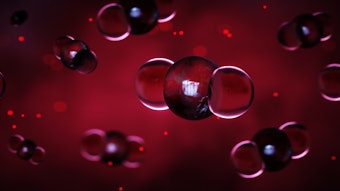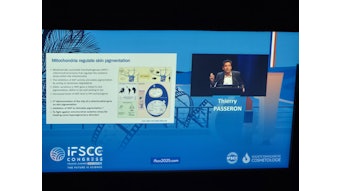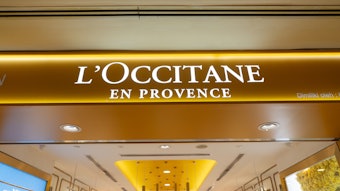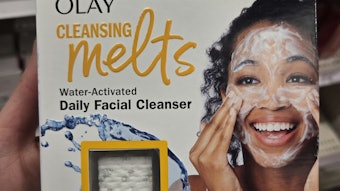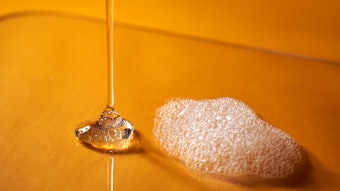The content of “Ingredient Profile” is provided for informational purposes only and is not intended as legal, regulatory or ingredient safety guidance. The author assumes no responsibility for misuse of the information presented herein.
Alkyl polyglucoside (APG) surfactants continue to be a popular choice of formulators seeking to improve the sustainability of cleansing products for personal care, hard surface cleaning, dishwashing, laundry, and industrial/institutional applications.1, 2 Made from 100% renewable starting materials and readily biodegradable in the environment, APGs are among the most commonly employed nonionic surfactants in so-called “green” cleansing products, and they routinely appear on the ingredient labels of personal cleansers marketed as “natural.” In cosmetic applications, decyl polyglucoside (INCI: Decyl Glucoside, see Figure 1) is the most frequently used APG,3 for it delivers reasonably high foaming and cleansing performance for a nonionic surfactant without the irritation potential of anionic detergents, such as alkyl sulfates and alkyl ether sulfates.
Chemistry and Manufacture
Chemical structure: Decyl glucoside (DG) is obtained by the condensation of decyl alcohol with glucose;4 note that the term glucose indicates the D stereoisomer throughout this article. This surfactant generally conforms to the chemical structure shown in Figure 1, consisting of a hydrophilic mono- or oligomeric glucoside head group linked to a hydrophobic C10 alkyl tail group.1, 5 The name decyl glucoside implies that DG is comprised of a C10 alkyl chain joined to a single glucose ring by an ether bond at the C-1 position. However, like all commercial-grade APGs, DG is a complex mixture of literally thousands of different compounds that arise due to:
- the two possible stereochemical orientations, i.e. the α- and β-anomeric forms at the C-1 carbon of the glucose moieties;
- the two possible isomeric forms of the glucose rings, i.e. pyranoside (six-member ring) and furanoside (five-member ring);
- the polydispersity of the oligoglucoside moieties;
- the multiple positions of the interglycosidic linkages for diglucosides and higher oligomers; and
- the distribution of alkyl chain lengths, which may vary from C8–C16 but have an average value of C10 for DG.
Hence, the term alkyl polyglucoside is not only indicative of the oligomeric nature of the glucoside head group, but also of the myriad structural variants that arise when fatty alcohols are condensed with glucose.3, 5 Also note that the term alkyl polyglucoside refers specifically to APGs derived from the sugar glucose, whereas the term alkyl polyglycoside refers more generally to the condensation products of alcohols with any sugar; e.g., mannose, galactose, xylose, fructose, etc.5
The glucoside head group of DG is comprised mainly of mono- and diglucosides along with smaller amounts of tri-, tetra-, and higher oligomeric glucosides; the average degree of polymerization (DP) for DG typically ranges from 1.4–1.8.6, 7 Chemical structures for some of the specific mono- and diglucosides that may be found in DG are shown in Figure 2.5 The alkyl tail group of DG has an average value of C10; however, the distribution normally includes alkyl chain lengths ranging from C8–C16.7–10
Feedstocks: The key feedstocks for preparing DG are C10 fatty alcohol (C10FA) and monomeric or polymeric carbohydrates.11–13 The C10FA may be of synthetic or vegetable origin, but those of vegetable origin are preferred due to their renewable nature. The carbohydrate feedstocks are derived from starch, a polymer of glucose, which may be obtained from corn, wheat or potatoes. Starch must be depolymerized via acid or enzymatic hydrolysis to obtain the monosaccharide glucose used in APG manufacture. However, synthetic processes for APGs have been developed that utilize a variety of carbohydrate feedstocks at various stages of depolymerization ranging from the polysaccharide itself, i.e., starch; to oligosaccharides, i.e., dextrose syrups; to monosaccharides, i.e., glucose monohydrate or anhydrous glucose.
APG processes starting with starch or dextrose syrups tend to require higher reaction temperatures to achieve efficient depolymerization and conversion to APGs. These higher temperatures can promote degradative side reactions, which lead to the formation of undesirable byproducts and colored impurities in the reactor product. On the other hand, glucose can be condensed with fatty alcohols at lower temperatures, thereby reducing the occurrence of deleterious side reactions and color formation. For the higher quality grade APGs employed in personal care applications, glucose tends to be the preferred starting material; thus, the present article will emphasize glucose-based routes.
Manufacture: The commercial preparation of DG and other APGs is based on the Fischer synthesis of alkyl glycosides, first reported by Nobel laureate Emil Fischer in the late 19th century.11 Fischer glycosidation is the acid-catalyzed condensation of alcohols with saccharides to yield alkyl (poly) glycosides with water as a byproduct. Although the chemistry is more than a century old, until recently, it proved challenging to master on an industrial scale. Nearly two decades of research and development were required to devise commercially viable processes for synthesizing APG surfactants with acceptable quality and performance. Successful commercialization was ultimately enabled by optimizing several critical factors, including reaction conditions, reactor design, distillation processes and post-reaction processing steps.1, 12–13 Industrial-scale production did not firmly take hold until the late 1980s, with large volumes only coming online in the early 1990s.
Figure 3 depicts the two principle routes that may be employed for the industrial-scale synthesis of DG: 1) the two-step transglycosidation route, and 2) the one-step direct glycosidation route.11–13 Both routes can be carried out either as batch or continuous processes. The two-step route has the advantage of being able to utilize any of the glucose feedstocks but it requires additional equipment to use and recover n-butanol, which is used as a solvent and intermediate reactant.
The transglycosidation route comprises two key steps: 1) synthesis of butyl glucoside (BG) as an intermediate, and 2) transglycosidation of the BG with C10FA to yield DG.5, 12 Note that BG may be obtained via butanolysis of starch or dextrose syrups, or via direct glycosidaton with glucose, as shown in Figure 4. In the first step, glucose is reacted with an excess of n-butanol at elevated temperature (100–110°C) in the presence of a strong acid catalyst such as p-toluenesulfonic acid or sulfuric acid. This reaction results in the formation of BG, also a mixture of isomers and oligomers, with water as a byproduct. The excess n-butanol and water are removed via vacuum distillation, and the n-butanol is recovered and reused in the process. The C4 alkyl substitution on BG facilitates improved compatibility between BG and the C10 fatty alcohol in the transglycosidation step. In that stage, BG is reacted with excess C10FA and an acid catalyst to form DG. The DP of the DG is governed by the ratio of C10FA to BG, and the reaction is driven by removal of n-butanol from the reactor by vacuum distillation.
Alternatively, glucose may be reacted directly with an excess of the C10FA in the presence of an acid catalyst to produce DG (see Figure 5). This route requires the more highly refined glucose as a starting material due to the insolubility of starch or dextrose syrups in molten C10 fatty alcohol. Direct glycosidation is made possible by feeding finely homogenized suspensions of glucose crystals in molten C10FA into the reactor, along with the catalyst and a reducing agent such as hypophosphorous acid. The reducing agent minimizes the formation of colored byproducts by inhibiting oxidative degradation reactions. By carefully controlling the glucose feed rate and residence time in the reactor, a homogenous reaction medium can be maintained and the formation of nonsurface- active polydextrose and other undesirable byproducts can be suppressed. The ratio of glucose to C10FA is also closely monitored to ensure that the target DP range is achieved. The reactor product from either reaction process typically consists of 20–50% crude DG and 50–80% excess C10FA that is not consumed in the reaction.13
Upon completion of the reaction, the reactor product undergoes several treatments to yield the finished DG surfactant.11–13 First, the acid catalyst is neutralized by addition of a base such as sodium carbonate, sodium hydroxide or magnesium oxide. The excess C10FA is then removed via multistage vacuum distillation operations using falling film, wiped-film and/or short-path evaporators to achieve residual C10FA levels of < 1% without subjecting the DG prolonged thermal stress. The resulting concentrated DG paste is diluted with water to ca. 50–70% solids and then bleached to reduce the color of the product. Bleaching usually involves treating the DG solution with hydrogen peroxide in the presence of magnesium ions (Mg2+) at pH values of 10–11 and temperatures of 80–90°C.11 Additional finishing steps may include the addition of preservatives and adjustment of pH or solids content in the DG product.
Properties
DG typically is supplied as a clear to slightly cloudy, slightly yellow aqueous solution containing ca. 50% w/w active matter and having viscosities of 500–6,000 cP.3, 8–10 Due to the exceptional stability of APGs in both alkaline and acidic conditions, DG solutions may be preserved by adjusting them to either very high or very low pH values. Thus, DG may be supplied at alkaline pH values of 11.5–12.5 or acidic pH values of 3–5. Some grades of DG may appear hazy at high pH levels due to the presence of Mg2+ ions but the haziness disappears if the pH is adjusted below pH 7. Impurities found in DG may include residual C10FA; unreacted glucose; inorganic ions, e.g., Na+, Mg2+ and SO4 2-; and traces of secondary products including polydextrose, ethers and colored byproducts. DG is reported to be nontoxic and nonsensitizing, and it is considered to be relatively nonirritating, except when the exposure involves high doses, long exposure times or occlusive conditions.3, 14
When dissolved in water, DG forms isotropic solutions of elongated or rodlike micelles at concentrations up to ca. 75% w/w.15 Unlike APGs with long alkyl chain lengths, e.g., lauryl glucoside (LG), DG solutions do not exhibit liquid crystalline phase formation except at very high concentrations (≥ 80% w/w). The cloud point of aqueous DG solutions typically exceeds 100°C due to the combination of a highly hydrated (poly)glucoside head group with a relatively short C10 alkyl tail group. Micelles of DG and other APGs tend to have a slight anionic character, as determined from zeta potential measurements. This negative charge is attributed to oxidation of a small fraction of the free –CH2OH groups to carboxylate groups (–COO–) during the bleaching process.
Technology and Applications
The main use of DG in personal care applications is as a primary or secondary cleansing and foaming surfactant in rinse-off products, including shampoos, body washes and sensitive skin washes, e.g., baby wash and facial cleansers.3, 4, 16 It delivers the best foaming performance of the APGs and tends to enhance the creaminess of lather of surfactant blends, e.g., when combined with sodium laureth sulfate. 16 Unlike LG, DG does not exhibit strong viscosity-building synergy when formulated with anionic surfactants; this is due to the shorter alkyl chain length, which leads to a lower value of critical packing parameter for DG and discourages the formation of entangled wormlike micelles.15, 16
Its use also has been reported in leave-on products, where it can function as an emulsifying agent or dispersing aid for pigments or hydrophobic ingredients. DG exhibits excellent compatibility with a wide variety of ingredients, including anionic, cationic and other nonionic surfactants, and it may be added to formulations at almost any point in the compounding process.
DG is generally recognized as a mild cleansing surfactant, and it is frequently positioned for use in cleansers for sensitive skin due to its dermatological compatibility. It is typically blended with more aggressive surfactants, e.g., anionics, to yield milder surfactant blends without sacrificing foam performance. A variety of in vitro and in vivo techniques have been used to validate the use of DG and other APGs for this purpose;3, 14, 16 however, a recent study17 has shown that although APGs are benign to the protein components of the skin, they are quite efficient at solubilizing skin lipids, leading to disruption of the skin barrier and increased skin dryness. This observation is not surprising, since APGs are also known to be excellent detergents in home care and industrial applications.1, 2 Therefore, when formulating with DG or other APGs, products should always be evaluated using the appropriate in vitro assays and in vivo clinical studies to confirm that the products are indeed nonirritating, and to substantiate claims of product mildness.
References
- Alkyl Polyglycosides: Technology, Properties and Applications, K Hill, W von Rybinski and G Stoll, eds, VCH Publishers, Inc, New York (1997)
- Nonionic Surfactants: Alkyl Polyglucosides, Surfactant Sci. Ser., Vol 91, D Balzer and H Lüders, eds, Marcel Dekker, Inc, New York (2000)
- www.cir-safety.org/sites/default/files/decylg-122011FRx.pdf (Accessed Jun 19, 2012)
- Decyl glucoside, monograph ID 4392, in the International Cosmetic Ingredient Dictionary and Handbook, 14th ed, Personal Care Products Council: Washington, DC (2012)
- H Lüders, Structure and nomenclature of surface-active alkyl glucosides, ch 2 in Nonionic Surfactants: Alkyl Polyglucosides, Surfactant Sci Ser, Vol 91, D Balzer and H Lüders, eds, Marcel Dekker, Inc, New York (2000) pp 7–18
- O Gorius, J-N Bertho and J-M Nuzillard, Determination and prediction of the average polymerization degree of alkyl polyglucosides, Analytica Chimica Acta 440(2) 231–237 (2001)
- AV Kühn and RHH Neubert, Characterization of mixtures of alkyl polyglycosides (Plantacare) by liquid chromatography-electrospray ionization quadrupole time-of-flight mass spectrometry, Pharm Res 21(12) 2347–2353 (2004)
- The Original APG: Plantacare 810 UP, Plantacare 818 UP, Plantaren 1200 N UP, Plantaren 2000 N UP, product data sheet, BASF Home and Personal Care NA: Florham Park, NJ (2011)
- Plantacare 2000 UP, technical data sheet, Cognis Care Chemicals, Düsseldorf, Germany (2004)
- Oramix NS10 decyl polyglucoside foaming agent, product brochure, SEPPIC Inc, Fairfield, NJ (2002)
- H Lüders, Synthesis of alkyl glucosides and alkyl polyglucosides, ch 3 in Nonionic Surfactants: Alkyl Polyglucosides, Surfactant Sci Ser, Vol 91, D Balzer and H Lüders, eds, Marcel Dekker, Inc, New York (2000) pp 19–76
- A Behler, M Biermann, K Hill, H-C Raths, M-E Saint Victor and G Uphues, Industrial surfactant synthesis, ch 1 in Reactions and Synthesis in Surfactant Systems, Surfactant Sci Ser, Vol 100, J Texter, ed, CRC Press, Boca Raton, FL (2005) pp 1–44
- R Eskuchen and M Nitsche, Technology and production of alkyl polyglycosides, ch 2 in Alkyl Polyglycosides: Technology, Properties and Applications, K Hill, W von Rybinski and G Stoll, eds, VCH Publishers, Inc, New York (1997) pp 9–22
- A Mehling, M Kleber and H Hensen, Comparative studies on the ocular and dermal irritation potential of surfactants, Food Chem Tech 45(5) 747–758 (2007)
- D Balzer, Surfactant properties, ch 5 in Nonionic Surfactants: Alkyl Polyglucosides, Surfactant Sci Ser, Vol 91, D Balzer and H Lüders, eds, Marcel Dekker, Inc, New York (2000) pp 85–278
- H Tessman, J Kahre, H Hensen and B Salka, Alkyl polyglycosides in personal care products, ch 5 in Alkyl Polyglycosides: Technology, Properties and Applications, K Hill, W von Rybinski and G Stoll, eds, VCH Publishers, Inc, New York (1997) pp 71–98
- C Vincent, KP Ananthapadamanabhan, M Vethamuthu, L Yang, A Cece and A Lips, Protein and lipid damage potential of surfactants and its relevance to mild cleansing, poster P311 presented at the 66th Annual Meeting of the American Academy of Dermatology, San Antonio, J Amer Acad Derm 58(2, suppl 2) AB30 (Feb 2008)


